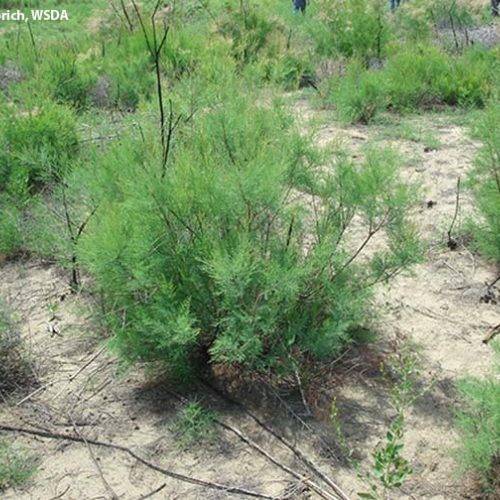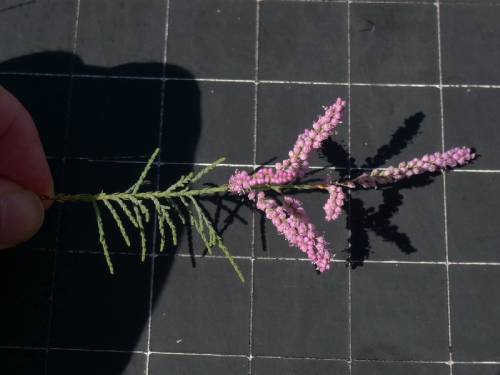Saltcedar identification and control
Information about the noxious weed saltcedar. Saltcedar is also known by its scientific name, Tamarix ramosissima.
About this weed
Saltcedar is a is a regulated Class B noxious weed in King County. This means control is required in King County under the state noxious weed law. Saltcedar is also on the Washington quarantine list and it is illegal to buy, sell or offer it for sale in the state.
Saltcedar is known as Tamarix ramosissima, also called pink tamarisk, and it is in the tamarisk family. Its native range is in southern Europe, northern Africa and parts of Asia, and it was introduced as a wind block for homesteads.

Why it's a problem
Saltcedar spreads readily, can adapt to a variety of habitats, and is very hard to remove. Saltcedar can produce hundreds of thousands of seeds per plant. It makes the surrounding soil very salty which inhibits the survival of other plants. This allows it to form monotypic stands (only one species of plant), lowering biodiversity. Saltcedar absorbs an enormous amount of water, even reducing water tables and drying wetlands. The taproot can extend almost 200 feet in search of water. Additionally, it can clog stream channels and trap sediment, contributing to increased flooding. Saltcedar offers little forage value or nesting habitat. It is invasive to arid regions of the western United States, including parts of eastern Washington.
Plant description
Saltcedar is commonly found along rivers and streams in arid regions. It needs moist soils and areas that are seasonally saturated/wet at the surface for seeds to germinate.
Saltcedar is a spreading shrub or small tree reaching 5 to 20 feet tall. Its leaves are small and scale-like, resembling a cedar tree, but turn yellow and drop off in the fall and winter. Stems have many branches and are reddish brown but may become covered with white salt deposits.
Flowers form in the spring at the ends of the branches. They are small but appear as large sprays of pink and last into the summer.
Seeds are dispersed by wind and on the water and new plants can sprout from roots and cuttings.



Be aware of look-alike plants
Saltcedar looks very similar to Small-flower tamarisk, Tamarix parviflora.
A non-native shrub typically found in eastern Washington. The two can be told apart with a close examination of the flowers. Small-flower tamarisk flowers have 4 sepals, 4 petals, and 4 stamens, while saltcedar has flowers with 5 sepals, 5 petals, and 5 stamens.
What to do if you find it
Property owners are required to control saltcedar on lands that they manage. Please notify us if you see saltcedar growing in King County. Our program staff can provide the property owner or appropriate public agency with site-specific advice on how best to remove it. Also, because saltcedar is not established in King County, we have a chance to stop it from spreading. We map all known locations of regulated noxious weeds to help us and others locate new infestations in time to control them.
Control methods
We recommend using a combination of methods to control noxious weeds. In areas with few weeds, it is important to act quickly before they become harder to control. Make a long-term plan as it often takes several years to get rid of most weeds. Start in the least infested areas first and then move into more heavily infested areas.
Plan to replant the area after removing the weeds. Use prolific desirable species to compete with any new saltcedar seedlings or other invasive weeds.
Mechanical control
Saltcedar will resprout from roots, so many mechanical methods have limited success. They can be effective when combined with other methods, though. Seedlings can be hand pulled. Root plowing can work if plowed 13 to 24 inches deep with a cutting blade equipped with fins to pull up roots and buried stems. Keep in mind, this method also destroys other vegetation.
Biological control
The saltcedar leaf beetle Diorhabda elongata adults and larvae feed on saltcedar foliage. Currently this beetle is not available in Washington. For more information about biological control of saltcedar, please visit Biocontrol Factsheets - NAISMA.
Chemical control
Stay safe when using herbicide:
- Always read the label before use.
- Wear a long-sleeved shirt, long pants, shoes, and eye protection.
- Follow state and local regulations.
Triclopyr and imazapyr are both effective herbicide products for saltcedar in either cut stump or foliar applications. Treatment should be done in the late summer or early fall and follow the herbicide specimen label for specific use instructions. Always read the label before using herbicide and follow state and local regulations.
Avoid spraying where herbicide may enter a waterway or wetland unless you are using a state-approved aquatic herbicide and have the required permits and licenses to do so. Use of pesticides in water is regulated in Washington state. See Washington Department of Ecology Aquatic Pesticide Permits for details.
For more information or a site-specific recommendation in King County, contact the noxious weed program. For information in other locations, contact your local weed board or extension office.
Disposal instructions
All roots, flowers, and seeds should be bagged and disposed of in the garbage. The rest of the plant can be piled to decompose onsite, but left unburied to avoid sprouting from cuttings.
Noxious Weed Disposal - Washington State Noxious Weed Control Board

 Translate
Translate